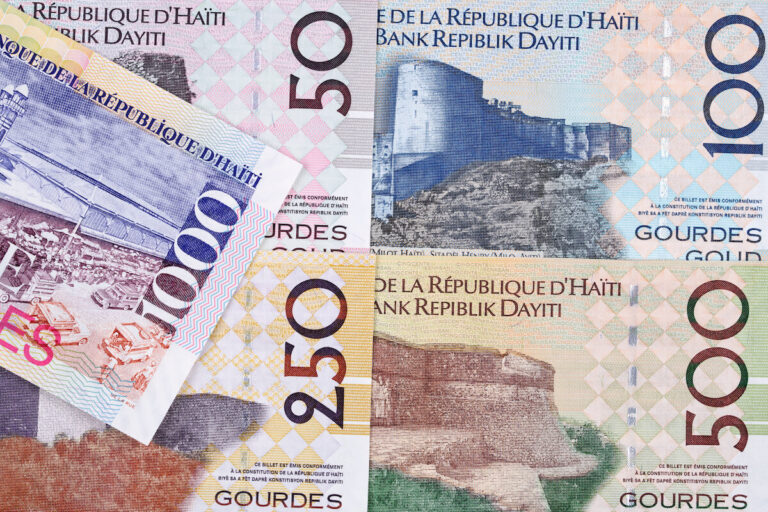Whether you’re traveling to Haiti or need to send money home to friends and family, this guide has all the information you need to know about the Haitian gourde. With over 200 years of history, the Haitian gourde is one of the oldest currencies still in use.
But first, let’s brush up on Haitian currency denominations, so you know what Haitian paper money looks like and why it’s divided up the way it is.
Haitian currency denominations
The Haitian gourde is the official currency of the Republic of Haiti, a Caribbean country that shares a land border with the Dominican Republic. Haiti has two official languages, French and Haitian Creole, both of which you can see on Haitian banknotes.
The currency code for the gourde is HTG, and the major issuing bank is the Bank of the Republic of Haiti, which replaced the National Bank in 1979.
The gourde divides into subunits called centimes, which equal 1/100th of a gourde. It comes in bills of 10, 25, 50, 100, 250, 500, and 1,000 gourdes. Haitian coins come in denominations of 5, 10, 20, and 50 centimes as well as 1- and 5-gourde coins.
Haiti is the only country that uses this currency. Demand for it is low outside the Republic of Haiti, as the country is financially small and not a large exporter. A large percentage of the population relies on subsistence farming, and about 20% of the country’s annual budget comes from foreign aid.
Fascinating facts about Haitian money
The gourde is a historically important currency infused with cultural pride. Here’s where the currency of Haiti comes from and how it has evolved over time.
1. Its name comes from an old Spanish currency.
The name “gourde” is French, but it comes from an old Spanish currency called gordos, short for “pesos gordos.”
The name evolved into the current spelling to reflect the French language. Many Creole speakers call gourdes “goud,” rhyming with the English word “mood.”
The symbol G represents the currency of the Haitian gourde.
2. The Haitian gourde first circulated in 1813.
The Haitian gourde first circulated as the currency of Haiti in 1813. Before the gourde’s introduction, the country used the French colonial livre.
The colonial livre was pegged to the French livre at par, which means that one colonial livre equaled one French livre. The livre divided into 20 sous, and 15 sous equaled one Spanish colonial real. So, essentially, the colonial livre was pegged to both French and Spanish currencies.
The introduction of the gourde in 1813 was one of the first steps in acknowledging the independence of Haiti. The gourde replaced the livre at a rate of eight livres and five sous for every one gourde.
The exchange rate complicated currency conversions during the first and second issues of the gourde, since it fluctuated with pegged currencies.
The franc soon rose to become the major currency in France, and in 1881, the gourde was pegged to the franc at a rate of five French francs to one gourde. This was before the introduction of euros in the European Union.
3. The gourde is now on its third issue.
The second issue of the gourde occurred in 1870 during the revaluation of the currency. The government issued banknotes for this new gourde in denominations of 10 and 25 gourdes, but coins were not released.
The third issue of the gourde appeared in 1872, and it’s still in use today. This involved another revaluation of the Haitian currency, at a rate of 300 second-issue notes to one third-issue note. The third gourde was pegged to the franc and later to the U.S. dollar (USD).
In the early years of the third gourde, banknotes were the only form of currency, and the name “piastre” was sometimes used instead of gourde.
4. Five gourdes is also called a Haitian dollar.
In 1912, the gourde was pegged to the U.S. dollar at a rate of five gourdes to 1 USD. The result? Haitians began to refer to five gourdes as a Haitian dollar and five centimes as a Haitian penny.
The gourde was unpegged from the USD in 1989 and is now a free-floating currency. Still, in many places, you may see prices in Haitian dollars instead of in gourdes, so you’ll need to multiply the number by five to convert it to gourdes.
For example, if you exit a local bus (or tap-tap, as they’re known in Haiti), and the driver asks for “two dollars,” this likely means two Haitian dollars, which is 10 gourdes. If a Haitian is referring to USD, they will probably say “American dollars.”
5. The gourde is one of a few currencies to feature a woman on a banknote.
The Haitian gourde banknotes are colorful and depict stories of important Haitian figures who helped to shape the country. On the back of each of the banknotes is the Haitian coat of arms. The only exception is the 1,000-gourde note, which depicts the Marche Valliere, a famous Haitian market, on the back.
The 10-gourde banknote bears the image of Catherine Flon, a symbol of the Haitian revolution. She reportedly sewed the first Haitian flag in 1803.
6. Some gourde notes mark important milestones.

The 1,000-gourde note first arrived on the scene in 1999, in order to commemorate the 250th anniversary of the founding of Port-au-Prince, Haiti’s capital.
A 20-gourde entered circulation in 2001, both as a commemorative edition to celebrate the bicentennial of the Constitution of Toussaint L’Ouverture and as a regular issue.
In 2004, the Banque de la Republique d’Haiti issued a series of notes to commemorate the bicentennial, ensuring that the images on the gourde are timely and relevant.
7. The U.S. Dollar is the second-most commonly accepted currency in Haiti.
As with many other countries in the Caribbean, the vast majority of businesses and individuals in Haiti will accept United States dollars. Vendors may prefer gourdes in places like outdoor markets, but will most likely accept USD as well.
Keep in mind that you’ll usually receive change in the local currency, so you may be better off converting U.S. dollars into Haitian gourdes before you visit.
Understanding Haitian gourde exchange rates
For many years, the currency of Haiti stayed the same in relation to the U.S. dollar, but now that it’s a free-floating currency, you’ll need to pay attention to the conversion rate when sending U.S. dollars to Haiti.
A variety of factors can affect the exchange rate. First and foremost is the stability of the Haitian economy, which can shrink or grow at different points throughout the year. The manufacturing industry often experiences fluctuations, while weather conditions can have an enormous impact on agricultural output.
Other unpredictable events, like political uprisings and natural disasters, can adversely affect the gourde exchange rate. Additionally, Central Bank interventions can cause a rapid appreciation of the gourde. To find the Haitian gourde’s current rates, you can use an online currency converter or check on the Remitly app.
Sending money to Haiti

Do you need to send money to Haiti? Remitly makes international money transfers faster, easier, more transparent, and more affordable. Our reliable and easy-to-use mobile app is trusted by over 5 million people around the world.
Download our app to get started and send your first transfer to Haiti today. Look for a promotion for first-time senders.

